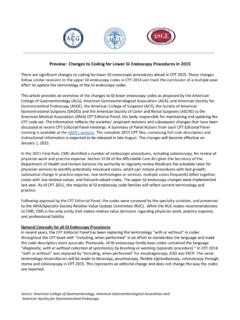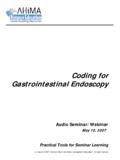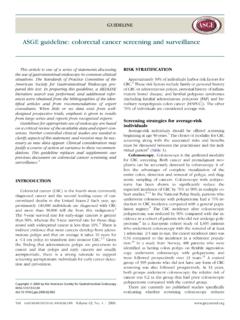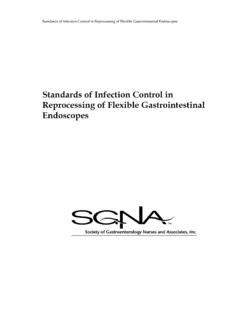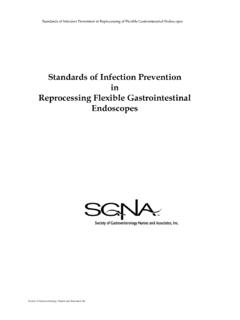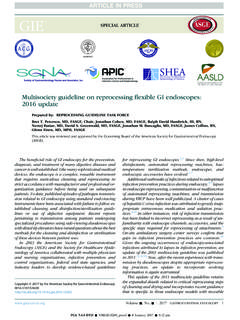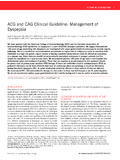Transcription of Antibiotic Prophylaxis for Total Joint Patients - Dr. …
1 Bacteremias occur when bacteria are shed into the blood stream and will occur as a result of acute infections in the mouth, skin, lung, gastrointestinal , and urogenital systems. These have been associated with late Total Joint infection. Probably the most critical period are the first two years after Joint replacement. The following recommendations are based on an advisory statement from the american Academy of Orthopedic Surgeons. Antibiotic Prophylaxis is not indicated for urological or dental Patients on the basis of pins, plates and screws. We do recommend most urological, dental Patients or Patients undergoing gastrointestinal endoscopy procedures with Total Joint replacements receive prophylactic antibiotics. This document should be printed out and presented to your treating physician. Antibiotic Prophylaxis can be obtained by calling our office prior to your dental procedure. Other Patients should be given antibiotics by the treating urologists and gastroenterologists.
2 Patients at Potential Increased Risk of Hematogenous Total Joint Infection All Patients during the first two (2) years after prosthetic Joint replacement. Immunocompromised/immunosuppressed Patients Inflammatory arthropathies ( : rheumatoid arthritis, systemic lupus erythematosus) Drug -induced immunosuppression Radiation-induced immunosuppression Patients with co-morbidities Previous prosthetic Joint infections Malnourishment Hemophilia HIV infection Diabetes Malignancy Risk Stratification of Bacteremic Urologic Procedures Higher Risk Any stone manipulation (includes shock wave lithotripsy) Any procedure with transmural incision into urinary tract (does not include simple ligation with excision or percutaneous drainage procedure) Any endoscopic procedures of upper tract (ureter and kidney) Any procedure that includes bowel segments Transrectal prostate biopsy Any procedure with entry into the urinary tract (except for transurethral catheterization) in individuals with higher risk of bacterial colonization.
3 Indwelling catheter or intermittent catheterization Indwelling ureteral stent Urinary retention History of recent / recurrent urinary tract infection or prostatitis Urologic Patients with Joint Replacements Antibiotic Prophylaxis for Patients with Total Joint Replacements Urinary diversion Lower Risk Endoscopic procedures into urethra and bladder without stone manipulation or incision (includes fulguration and mucosal biopsy, if no incision) Open surgical or laparoscopic procedures without stone manipulation or incision into the urinary tract Catheterization for drainage or diagnostic instrumentation, including both transurethral and percutaneous access Patients at Potential Increased Risk of Hematogenous Total Joint Infection All Patients during the first two (2) years after prosthetic Joint replacement. Immunocompromised/immunosuppressed Patients Inflammatory arthropathies ( : rheumatoid arthritis, systemic lupus erythematosus) Drug -induced immunosuppression Radiation-induced immunosuppression Patients with co-morbidities Previous prosthetic Joint infections Malnourishment Hemophilia HIV infection Insulin-dependent (Type 1) diabetes Malignancy Incidence Stratification of Bacteremic Dental Procedures Higher Incidence Dental extractions Periodontal procedures including surgery, subgingival placement of Antibiotic fibers/strips, scaling and root planing, probing, recall maintenance Dental implant placement and replantation of avulsed teeth Endodontic (root canal)
4 Instrumentation or surgery only beyond the apex Initial placement of orthodontic bands but not brackets Intraligamentary and intraosseous local anesthetic injections Prophylactic cleaning of teeth or implants where bleeding is anticipated Antibiotic Prophylaxis FOR Patients WITH Total JOINTS Page 2 Antibiotic Recommendations for Urologic Patients 1. A single systemic level dose of a quinolone ( , ciprofloxacin, 500 mg; levofloxacin, 500 mg; ofloxacin, 400 mg) orally one to two hours preoperatively. 2. Ampicillin 2 gm IV (or Vancomycin 1 gm IV over 1 to 2 hours, in Patients allergic to ampicillin) plus Gentamicin mg/kg IV 30 to 60 minutes preoperatively. 3. For some procedures, additional or alternative agents may be considered for Prophylaxis against specific organ-isms. Dental Patients with Total Joint Replacements Urologic Patients with Joint Replacements Lower Incidence Clinical judgment may indicate Antibiotic use in selected circumstances that may create significant bleeding.
5 Restorative dentistry (operative and prosthodontic) with/without retraction cord Local anesthetic injections (nonintraligamentary and nonintraosseous) Intracanal endodontic treatment; post-placement and buildup Placement of rubber dam Postoperative suture removal Placement of removable prosthodontic/orthodontic appliances Taking of oral impressions Fluoride treatments Taking of oral radiographs Orthodontic appliance adjustment This includes restoration of carious (decayed) or missing teeth. Page 3 Antibiotic Prophylaxis FOR Patients WITH Total JOINTS Dental Patients with Total Joint Replacements Antibiotic Recommendations for Dental Patients 1. Patients not allergic to penicillin: cephalexin, cephradine or amoxicillin: 2 grams orally 1 hour prior to dental pro-cedure. 2. Patients not allergic to penicillin and unable to take oral medications: cefazolin 1 gram or ampicillin 2 grams IM/IV 1 hour prior to the procedure.
6 3. Patients allergic to penicillin: clindamycin: 600 mg orally 1 hour prior to the dental procedure. 4. Patients allergic to penicillin and unable to take oral medications: clindamycin 600 mg IV, 1 hour prior to the proce-dure. 5. No second doses are recommended for any of these dosing regimens. The american society for gastrointestinal endoscopy has published the following consensus statements regarding Antibiotic Prophylaxis during endoscopic procedures for infective endocarditis. It is our belief that all Patients with Total Joint replacements, especially those in the high risk groups already mentioned, be given prophylactic antibiotics prior to endoscopic procedures. All Patients within 2 years of Joint replacement should be considered high risk for infection from a bacteremia. For most endoscopic procedures, including upper endoscopy , sigmoidoscopy, and colonoscopy with or without mucosal biopsy, polypectomy, and/or nonvariceal hemostasis: Antibiotic Prophylaxis is not recommended for Patients with lesions at intermediate risk for the development of endocarditis, or those with lesions or conditions at no increased risk for endocarditis compared to the general population.
7 For example Patients with mitral valve prolapse, with or without regurgitation do not require Prophylaxis for any of the above procedures. There are insufficient data to recommend routine Prophylaxis for Patients at high risk for infective endocarditis. The endoscopist may consider Prophylaxis on a case-by-case basis. For endoscopic procedures associated with increased rates of transient bacteremia, including dilation of an esophageal stricture, varix sclerotherapy, and retrograde cholangiography with known or suspected bile duct obstruction: Prophylaxis is recommended for Patients at high risk for the development of endocarditis. This would also apply to Patients with Total joints within 2 years of implantation and those considered high risk for infection. No Prophylaxis is recommended for Patients with those cardiac lesions and conditions at no increased risk for infective endocarditis over the general population. However, it is recommended that all Patients with suspected or known biliary obstruction should receive prophylactic antibiotics prior to ERCP.
8 There are insufficient data to recommend routine Prophylaxis for Patients with cardiac lesions or conditions at intermediate risk for the development of infective endocarditis. The endoscopist may consider Prophylaxis on a case-by-case basis. Antibiotic Prophylaxis FOR Patients WITH Total JOINTS Page 4 GI Patients with Total Joint Replacements Antibiotic Recommendations for gastrointestinal endoscopy Patients 1. Standard general Prophylaxis : Amoxicillin g po (adult) or 50 mg/kg po (child), 1 hour prior to the procedure. Alternative for those unable to take po is Ampicillin g IV/IM (adult) or 50 mg/kg IV/IM (child), within 30 min before procedure. 2. Penicillin-allergic Patients : Clindamycin 600 mg po (adult) or 20 mg/kg po (child), 1 hour prior to proce-dure. Alternatives: Cephalexin or cefadroxil g po (adult) or 50 mg/kg po (child), 1 hour prior to the procedure. Azithromycin or clarithromycin 500 mg po (adult) or 15 mg/kg po (child), 1 hour prior to pro-cedure.
9 3. Penicillin-allergic Patients unable to take po: Clindamycin 600 mg IV (adult) or 20 mg/kg IV (child), within 30 min before procedure. Alternative: Cefazolin gm IV/IM (adult) or 25 mg/kg IV/IM (child) within 30 min before the procedure. Vancomycin gm IV (adult) or 10-20 mg/kg (child).




